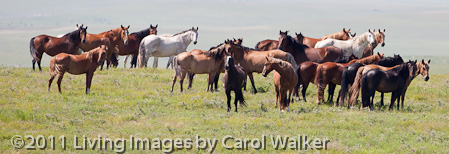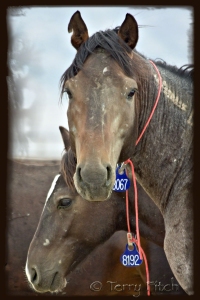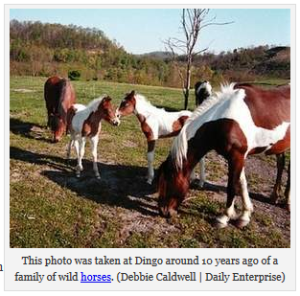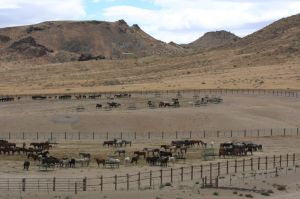Straight from the Horse's Heart
75 wild mares died in a very short amount of time at BLM’s emergency short term holding facility in Scott City, Kansas.

Mares look at the public on a BLM tour of Long Term Holding pastures in Kansas. (photo by Carol Walker)
The BLM awarded the contract for an emergency short term holding facility to Phil Jennings, who has the contract for the BLM’s Pauls Valley facility in Oklahoma. Jennings has had contracts with BLM since 2005 for Pauls Valley, and the obligation amounts seemed to be mostly in about the $100,000 to $300,000 range.
The BLM Scott City, KS emergency short term holding facility contract was signed 6/4/2014, and the obligation amount is $2,030,000. Yep, that’s a jump to over $2 million dollars.
But Jennings is in Pauls Valley, Oklahoma. That’s about a 400 mile drive to Scott City, Kansas. It seems Jennings may have LEASED the feedlot run by Beef Belt, LLC in Scott City, KS. So, in essence, BLM’s contractor hired a subcontractor.
(Does that seem to make Jennings a very well paid middleman?)
If a contractor leases a feedlot from what is in essence a subcontractor, then the subcontractor has no direct contract with instructions and obligations to the BLM, does it? Did any BLM personnel give written instructions and obligations to Beef Belt, LLC, which was formed in 10/1/13 (just 9 months prior to getting this windfall of business)? Or.was it only after 70 horses died, that the BLM finally seemed to get concerned or involved, and give instructions about the feed?
“The manager of the corral, Steven Landgraf, one of the owners of Lakin Feed Yard, which specializes in corrals just like the one in Scott County, denied any wrongdoing on the part of the staff at the corral.
“We did our best to take care of them. It is not like we did not do our job,” Landgraf said. “As animals get older, they die. The animals that have died have all been between 19 and 20 years old. It is a fact of life; how do you say this without being cruel?”
Landgraf explained further that the organization has cows and buffaloes that die there frequently.
“It is normal to have 4 percent or 5 percent of deaths with cattle, so this does not really count as out of the ordinary,” he said. “There were 1,490 of them that came in, and, if these few died, it shouldn’t be such a big deal.”
(He also added “I have a cow herd. When the cattle get to be this old, we sell them so they can be turned into hamburger.”)
Well, Mr. Landgraf, you may not have noticed yet, but this is a REALLY BIG DEAL to the American public.
And about all the buffalo and cattle that Mr. Landgraf mentioned that died on the feedlot, doesn’t it make you wonder about the condition of the soil and any possible toxins? Did the BLM even do any soil tests or an Environmental Assessment for this feedlotbefore putting wild horses on it?
The hutchtimes.com article also included quotes from Paul McGuire, BLM’s public affairs specialist. It stated “According to McGuire, it is part of the contractual arrangement that if there are deaths on these private holdings, they must be reported immediately.”
But how long after the deaths was it before the BLM notified the public? The BLM buried this vague “notification” in their “From the Public” page on the Wild Horse & Burro Program website:
Question: Does the BLM ever move animals from a long-term pasture to another holding facility? If so, why? (July 2014)
Answer: Yes, BLM moves animals from long-term pastures to other facilities if the long-term pasture can no longer accommodate the animals. Examples of when this would occur include:
1. If a contractor sells the ranch and the new owner does not want to manage for wild horses.
2. If a contractor has lands recovering from drought and wants to remove grazing animals or decrease their numbers to aid in drought recovery.
3. If market conditions change in the livestock sector such that the contractor identifies a more lucrative use for the land.
Depending on the capacity of the facility needing to relocate animals, the number of animals being relocated can range from a few hundred to a few thousand head.
The majority of animals that have not been adopted are held on long-term pastures. Long-term pastures provide a free-roaming environment for the animals and it costs less for the taxpayer to house animals on long-term pastures than at short-term holding facilities. With long-term and short-term facilities nearly filled to capacity, the BLM is currently seeking new short-term and long-term holding facilities.”
Uh, this didn’t mention that even one wild mare died at Scott City, did it? And how many of you comb the “From the Public” page on the BLM’s WH & B website on a daily basis?
Finally, on 8/15/14, the BLM posted a news release on their “News & Information” page of the WH & B Program website.
The BLM’s Wild Horse & Burro Program website “From the Public” page is also where the BLM seems to have buried the last “update” on the ongoing investigation into Spur Livestock selling wild horses to kill buyer Joe Simon by stating:
Question: What is the BLM’s response to allegations regarding wild horse sales to a South Dakota long-term pasture contractor, known as Spur Livestock, in 2008?
Answer: The BLM cares deeply about the well-being of wild horses and burros, both on and off the range, and takes seriously all accusations of the slaughter of wild horses or burros. These accusations have been forwarded to BLM Law Enforcement, which is investigating. The BLM will share the findings of the investigation once it is complete.
And also, about the ongoing investigation of Tom Davis, prolific buyer of truckloads of wild horses that went who knows where:
Question: What is the BLM’s reaction to allegations regarding horse sales to Tom Davis of Colorado, as reported by Pro Publica?
Answer: The BLM condemns any sale of wild horses for slaughter. We care deeply about the well-being of wild horses, both on and off the range, and it has been (and remains) the policy of the BLM not to sell or send wild horses or burros to slaughter. We take seriously all accusations of the slaughter of wild horses or burros. The Office of the Inspector General at the Department of the Interior has initiated an investigation into the situation and will work in conjunction with the State of Colorado throughout its investigation. We look forward to the results of that inquiry. Anybody that is found to have violated the 1971 Wild Free-Roaming Horses and Burros Act should be held accountable.
We’re still looking forward to results of this inquiry, too. And we have been for a long time now. May we all live into our 100’s, so we can finally find out the results.
Bottom line, if the BLM had left these wild horses on their (supposedly) “federally protected” Herd Management Areas where they belong, the wild horses, especially older, more vulnerable ones, wouldn’t be getting shipped all over the country, stressed out, and having to adjust to different feed.



















